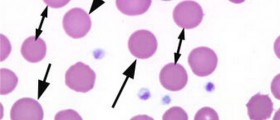Healthy Ferritin
Ferritin is the protein in the blood, responsible for binding the iron. These binds of ferritin and iron are the storage for iron in the body, and the free ferritin found in your blood will reveal the level of body iron. Normally, ferritin can be found in small quantities in the blood, and also in skeletal muscles, bone marrow, liver, and spleen.Ferritin blood test will show the level of free ferritin in the blood. It is usually done in patients suffering from anemia or inflammation, and to check the patient for the hemochromatosis (too much iron in the body). Another reason for a doctor to request ferritin blood test might be a certain treatment, which should/could show change the level of blood iron.

Blood Test
The blood draw for ferritin testing is the same as any blood draw. The procedure might be slightly uncomfortable but it is not painful, and it lasts for a minute or two at the most. Sometimes, there might be a bruise after the blood draw and (extremely rarely) the vein a blood sample was taken from might get swollen. People with coagulation problems, who are taking warfarin (or other blood thinners) or Aspirin should inform their doctor before the blood drawing.
Blood Test Results
Normal values for the adults are different for men and women. The usual amount of ferritin in men is 18-270mcg/l and in women 18-160mcg/l.
In newborn babies, ferritin levels are about 25-200mcg/l, and in 1 month old babies about 200-600mcg/l. Older babies, 2 to 5 months old, should have 50-200 mcg/l and children up to 15 years of age 7-142mcg/l of ferritin.
Causes of high ferritin in the blood include: increased intake of iron from the diet, inflammation, infection, leukemia, liver problems or Hodgkin’s disease. Ferritin level higher than 100mcg/l indicates the accumulation of iron in the body, causing a condition called hemochromatosis. Causes of this condition might be genetic predisposition, some types of anemia, thalassemia or alcoholism, and sometimes blood transfusion. Buildup of iron in the heart or pancreas can seriously affect these organs.
Low ferritin indicates iron deficiency. The possible causes include: diet low in iron and blood loss from the intestinal bleeding, pregnancy or heavy periods. Rarely, the cause of low iron could be the loss of iron through the skin (present in psoriasis).
In some cases, the results might not be accurate. These include:
Age (elderly people have higher ferritin levels)
Female athletes
Diet rich in red meat
Recent blood transfusion
Recent radioactive scan
Present inflammation
Use of contraception pills and thyroid medications.
Ferritin Levels and Covid-19
- In one study with 20 COVID-19 patients, it was found that individuals with severe and very severe COVID-19 exhibited increased serum ferritin level, being serum ferritin in the very severe COVID-19 group significantly higher than in the severe COVID-19 group.
- In agreement with this, another study revealed that in patients who died by COVID-19, ferritin levels were high upon hospital admission and throughout the hospital stay. The median values of serum ferritin levels after day 16 of hospitalization exceeded the upper limit of detection in these patients, suggesting that ferritin levels increased non-stop.
- Also, Chen et al. analyzed the clinical characteristics of 99 patients, in which 63 of them had serum ferritin way above of the normal range 9. Elevated ferritin levels were found also in autopsies of 12 patients whose cause of death was SARS-CoV-2 infection.
- An analysis of the peripheral blood of 69 patients with severe COVID-19 revealed elevated levels of ferritin compared with patients with non-severe disease.

















Your thoughts on this
Loading...